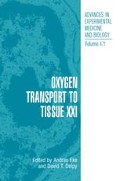Abstract
Nitric oxide (NO) plays an important role in the regulation of the cerebral blood flow (CBF) (for review see: Faraci and Heistad, 1998). Inhibition of the L-arginine—NO pathway results in cerebral vasoconstriction and reduction of the CBF, indicating that the basal release of NO provides a resting relaxant tone in the cerebrovascular bed (for review see: Iadecola et al., 1994). This effect of basal NO production has generally been regarded as a direct relaxant action on the smooth muscle. The possibility that NO may regulate the resting cerebrovascular tone by modulation of the prostanoid synthesis has not been investigated to date.
Access this chapter
Tax calculation will be finalised at checkout
Purchases are for personal use only
Preview
Unable to display preview. Download preview PDF.
References
Benyó Z, Görlach C, and Wahl M (1997) Neuronal nitric oxide synthase is involved in agonist-induced but not in basal nitric oxide release in isolated rat basilar arteries. J Cereb Blood Flow Metab 17(Suppl 1):S345.
Benyó Z, Görlach C, and Wahl M (1998a) Involvement of thromboxane A2 in the mediation of the contractile effect induced by inhibition of nitric oxide synthesis in isolated rat middle cerebral arteries. J Cereb Blood Flow Metab 17:616–618.
Benyó Z, Görlach C, and Wahl M (1998b) Role of nitric oxide and thromboxane in the maintenance of cere-brovascular tone. Kidney Int 54(Suppl 67):S218–S220.
Bredt DS, Hwang PM, and Snyder SH (1990) Localization of nitric oxide synthase indicating a neural role for nitric oxide. Nature 347:768–770.
De Clerck F, Beetens J, de Chaffoy de Courcelles D, Freyne E, and Janssen PAJ (1989) R 68 070: Thromboxane A2 synthase inhibition and thromboxane A2/prostaglandin endoperoxide receptor blockade combined in one molecule—I. Biochemical profile in vitro. Thromb Haemostas 61:35–42.
Descombes J-J, Devys M, Laubie M, and Verbeuren TJ (1993) Endothelial thromboxane production plays a role in the contraction caused by 5-hydroxytryptamine in rat basilar arteries. Eur J Pharmacol 243:193–199.
Faraci F and Heistad DD (1998) Regulation of the cerebral circulation: Role of endothelium and potassium channels. Physiol Rev 78:53–97.
Gorelova E, Loesch A, Bodin P, Chadwick L, Hamlyn PJ, and Burnstock G (1996) Localisation of immunore-active factor VIII, nitric oxide synthase, substance P, endothelin-1 and 5-hydroxytriptamine in human postmortem middle cerebral artery. J Anat 188:97–107.
Görlach C and Wahl M (1996) Bradykinin dilates rat middle cerebral artery and its large branches via endothelial B2 receptors and release of nitric oxide. Peptides 17:1373–1378.
Hellyer PW, Johnson LW, and Olson NC (1997) Effect of NG-nitro-L-arginine-methyl-ester on cardiopulmonary function and biosynthesis of cyclooxygenase products during porcine endotoxemia. Crit Care Med 25:1051–1058.
Iadecola C (1997) Bright and dark sides of nitric oxide in ischemic brain injury. Trends Neurosci 20:132–139.
Iadecola C, Pelligrino DA, Moskowitz MA, and Lassen NA (1994) Nitric oxide synthase inhibition and cere-brovascular regulation. J Cereb Blood Flow Metab 14:175–192.
Kelly PAT, Ritchie IM, and Arbuthnott GW (1995) Inhibition of neuronal nitric oxide synthase by 7-niroin-dazole: effects upon local cerebral blood flow and glucose use in the rat. J Cereb Blood Flow Metab 15:766–773.
Kovách AGB, Lohinai Z, Marczis J, Balla I, Dawson TM, and Snyder SH (1994) The effect of hemorrhagic hypotension and retransfusion and 7-nitro-indazole on rCBF, NOS catalytic activity, and cortical NO content in the cat. Ann NY Acad Sci 738:348–368.
Nozaki K, Moskowitz MA, Maynard KI, Koketsu N, Dawson TM, Bredt DS, and Snyder SH (1993) Possible origins and distribution of immunoreactive nitric oxide synthase-containing nerve fibers in cerebral arteries. J Cereb Blood Flow Metab 13:70–79.
Salvemini D (1997) Regulation of cyclooxygenase enzymes by nitric oxide. Cell Mol Life Sci 53:576–582.
Silva MT, Rose S, Hindmarsh JG, Aislaitner G, Gorrod JW, Moore PK, Jenner P, and Marsden CD (1995) Increased striatal dopamine efflux in vivo following inhibition of cerebral nitric oxide synthase by the novel monosodium salt of 7-nitro indazole. Br J Pharmacol 114:257–258.
Spatz M, Kawai N, Merkel N, Bembry J, and McCarron RM (1997) Functional properties of cultured endothelial cells derived from large microvessels of human brain. Am J Physiol 272:C231–C239.
Stadler J, Harbrecht BG, Di Silvio M, Curran RD, Jordan ML, Simmons RL, and Billiar TR (1993) Endogenous nitric oxide inhibits the synthesis of cyclooxygenase products and interleukin-6 by rat Kupffer cells. J Leukoc Biol 53:165–172.
Wang G-R, Zhu Y, Halushka PV, Lincoln TM, and Mendelsohn ME (1998) Mechanism of platelet inhibition by nitric oxide: In vivo phosphorylation of thromboxane receptor by cyclic GMP-dependent protein kinase. Proc Natl Acad Sci USA 95:4888–4893.
Wang Q, Pelligrino DA, Baughman VL, Koenig HM, Albrecht RF (1995) The role of neuronal nitric oxide synthase in regulation of cerebral blood flow in normocapnia and hypercapnia in rats. J Cereb Blood Flow Metab 15:774–778.
Zagvazdin Y, Sancesario G, Wang YX, Share L, Fitzgerald ME, and Reiner A (1996) Evidence from its cardiovascular effects that 7-nitroindazole may inhibit endothelial nitric oxide synthase in vivo. Eur J Pharmacol 303:61–69.
Author information
Authors and Affiliations
Editor information
Editors and Affiliations
Rights and permissions
Copyright information
© 1999 Springer Science+Business Media New York
About this chapter
Cite this chapter
Benyó, Z., Görlach, C., Wahl, M. (1999). Interaction between Nitric Oxide and Thromboxane A2 in the Regulation of the Resting Cerebrovascular Tone. In: Eke, A., Delpy, D.T. (eds) Oxygen Transport to Tissue XXI. Advances in Experimental Medicine and Biology, vol 471. Springer, Boston, MA. https://doi.org/10.1007/978-1-4615-4717-4_45
Download citation
DOI: https://doi.org/10.1007/978-1-4615-4717-4_45
Publisher Name: Springer, Boston, MA
Print ISBN: 978-1-4613-7137-3
Online ISBN: 978-1-4615-4717-4
eBook Packages: Springer Book Archive

